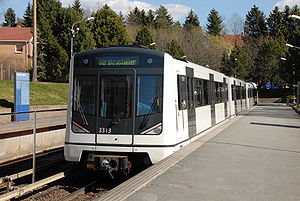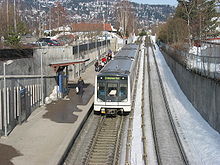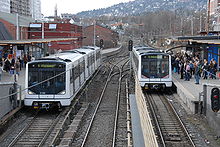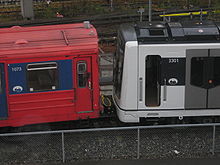- OS MX3000
-
MX3000
An MX3000 at BergkrystallenIn service 2007–present Manufacturer Siemens Replaced T1000/T1300 Constructed 2005-2012 (scheduled) Number built 83 (delivered by 2010)
32 (on order)Formation 3 or 6 cars per trainset Operator Oslo T-banedrift Line(s) served Oslo Metro Specifications Car length 54.14 m (177.6 ft) (3 cars) Width 3.16 m (10.4 ft) Height 3.68 m (12.1 ft) Maximum speed 70 km/h (43 mph) Weight 98 t (96 long tons; 108 short tons) (empty)
147 t (145 long tons; 162 short tons) (with payload)Electric system(s) 750 V third rail Safety system(s) ATP Gauge 1,435 mm (4 ft 8 1⁄2 in) MX3000 is an electric train used on Oslo Metro in Oslo, Norway. The multiple units are produced by Siemens, who started serial delivery in 2007. Seventy-eight three-car units have been ordered by Kollektivtransportproduksjon, and five by Akershus County Municipality. They replaced the older T1000 and T1300 stock that was used on the Oslo Metro since 1966. By 2010, the last T1000 and T1300 trains have been retired and replaced by 83 three-car units. By 2012, the final delivery will increase the fleet to 115 units.
The trains are built as units of three cars, though they are often operated as double units. The units are 54.14 meters (177.6 ft) long, and weigh 98 tonnes (96 long tons; 108 short tons) empty. They have a power output of 1,680 kilowatts (2,250 hp), allowing speeds of 70 km/h (43 mph). Seated capacity is 138 seats, and total capacity is 493 riders. New features for the Oslo Metro introduced with the MX3000 include air suspension, regenerative brakes and batteries for operating at the depot. The first series of 33 units were ordered in 2003, followed by an additional order for 30 in 2005, 15 in 2008, and 32 in December 2010.[1] The trains have been financed by Oslo Package 2, and each unit costs about NOK 45 million.
History
In 1966, the Oslo Metro opened as an upgrade of two existing suburban tramways, the Østensjø- and Lambertseter Lines. By 1970, the system was supplemented by the Grorud- and Furuset Lines. They only operated to the eastern suburbs.[2] In 1987, the system was expanded to connect to the western network, that remained a suburban tramway with overhead wires, two-car platforms and an inferior signaling system. In 1993, the Sognsvann Line was converted to metro standard, with the Røa Line following two years later.[3] When the order for the MX3000 trains was placed, the Kolsås- and Holmenkoll Lines still used overhead wires, and would not be able to use the new stock. Both systems were at the time being considered for conversion to light rail systems, that would connect to the Lilleaker- and Ullevål Hageby Line, respectively.[4][5]
The old fleet of T1000 and T1300 consisted of 195 cars in eight series.[6][7] The T1000 was the original series delivered between 1966 and 1978,[8][9] while the T1300 was a later adoption built until 1987. The T1000 series has only a third rail shoe, while the T1300 also has a pantograph, and could be used on the Kolsås- and Holmenkoll Lines.[10] In 1995, six two-car T2000 units were delivered for the Holmenkoll Line. They were, at the time, proposed as a possible replacement for all the T1000 and T1300 stock, but were prone to technical problems. They featured both third rail shoes and pantographs.[7]
In 1996, the work to establish a financing package for new investments in public transport in Akershus and Oslo started. It was passed, in 2001, by the city and county councils, as well as the Norwegian Parliament. Oslo Package 2 allowed municipal and state grants to be supplemented by increased fare and toll road revenue to finance, among other things, new trains for the metro. The initial order by Oslo Sporveier was for 33 units (or 99 cars), and was approved by the board on 28 June 2003. The initial order cost NOK 1.6 billion, and included options for further orders. Five other manufactures had been rejected during the procurement process. Combined with other investments in the network, the new trains will allow faster travel times on the metro.[11][12][13]
In 2005, the city council voted to replace all existing T1000 and T1300 stock with the MX3000, increasing the quantity by another 30 units.[6] With the second order, the price had increased to NOK 2.5 billion.[14] Two test units were delivered in October 2005, and the serial production started in April 2006, with the first deliveries in April 2007. With the delivery of the new trains, Oslo Sporveier received criticism that they had been disloyal to the old red color of the metro, and that they did not follow up on their former design concept from the 1960s through the 80s.[15] During the first 30 days, there occurred two errors: one in the closing mechanism of the doors, and one with a switch in the cab that was not water tight. However, it turned out that Oslo Sporveier had not been accurate enough in specifying the energy consumption of the trains, and the rectifiers on parts of the line needed to be upgraded to supply sufficient power to the trains.[16] During 2007, there were four incidents where the trains were not able to brake at stations. The worst incident occurred when a train slid the 1.3 kilometers (0.81 mi) from Blindern to Majorstuen.[17]
Following the 2006 decision to convert the Kolsås Line to metro standard, Akershus County Council announced they would order five units.[18] In November 2006, the city government proposed that the maintenance of the new trains be privatized. This resulted in protests from the employees, who campaigned by refusing to work overtime. As a result, after a few weeks, the company lacked 57 trains to provide adequate service.[19] The issue was solved when the socialist opposition parties along with the Liberal Party agreed to postpone the matter until after all the new trains were delivered in 2009. As part of the agreement, a new limited company, Oslo Vognselskap, wholly owned by Kollektivtransportproduksjon, would take ownership of all metro trains and trams used by the operating companies Oslo T-banedrift and Oslo Sporvognsdrift, the latter being the operator of the tramway. Responsibility for the debt accumulated for buying the trains is to be managed by Oslo Vognselskap, while operation and management of the maintenance contracts was transferred to Oslo T-banedrift.[20]
In January 2008, an addition 15 units were ordered by Oslo, with an option for further orders later. This will allow all the eastern lines to have a 7.5-minute headway on their services into the city center, instead of the current 15-minute headway. Trains would start using the balloon loop located at Stortinget, and the western lines will continue to have a 15-minute headway. At the same time, the trains serving the Ring Line will be extended to six cars.[21] The order cost NOK 675 million. In addition, Akershus finalized their order for five units, costing NOK 240 million. Unlike the Oslo-owned units, Akershus' five units will be owned by the transit authority Ruter.[22] The same year, the city council in Oslo decided to upgrade the Holmenkoll Line to metro standard, to allow six-car MX3000 trains to be the main mode of transport to Holmenkollen during the FIS Nordic World Ski Championships 2011. This allowed 9,000 people per hour to be transported to the sports venue.[23] In 2009, the T2000 units were taken out of service, and on 22 April 2010 the last T1300 was taken out of service, making the MX3000 the only units to be used on the Oslo Metro.[24][25] The city council was considering ordering 15 additional MX3000 to replace the T2000, as an alternative for a NOK 50-million renovation.[26]
In November 2010, the Accident Investigation Board Norway criticized the braking system of the trains. During 2009, there were 83 incidents where trains with locked wheels slid down steep sections of track. The Accident Investigation Board found that the metro had conducted insufficient testing of the braking system on steep slippery lines, had not adjusted the brakes satisfactorily, and had not maintained the trains and tracks sufficiently.[27] In December 2010, Oslo Vognselskap ordered another 32 three-car units, bringing the total order up to 115 three-car units. The last trains will be delivered in 2012.[28] There was political disagreement regarding the final purchase, with the Liberal Party and socialist opposition securing a majority for the purchase, while the right-winged parties voted to order 19 units. The extra trains will make it possible to run all lines except the Holmenkollen Line (Line 1) with six-car lines, compared to a situation with only three-car trains on the Lambertseter Line, the Ring Line and the Kolsås Line (lines 4 and 6) would only use three-car trains.[29]
Specifications
The MX3000 is a three-car electric multiple unit built exclusively for the Oslo Metro by Siemens in Vienna, Austria. It is a modification of trains used on the Vienna U-Bahn.[6] The units are designed by Porsche Design Studio.[30] Unlike the red predecessors, the trains are painted white with black and grey detailing. The chassis is in aluminum. A three-car train is 54.14 meters (177.6 ft) long; the end cars are 18.11 meters (59.4 ft) long each, while the center car is 17.92 meters (58.8 ft) long. The cars are 3.16 meters (10.4 ft) wide and 3.68 meters (12.1 ft) tall. An empty three-car unit weighs 98 tonnes (96 long tons; 108 short tons), while it with full payload weighs 147 tonnes (145 long tons; 162 short tons). This gives a maximum axle load of 12.5 tonnes (12.3 long tons; 13.8 short tons).[6][31]
Each three-car unit has 138 seats, and a total capacity of 493 riders. The height of the floor is 1.12 meters (3 ft 8 in) above the track, allowing step-free access to the platforms. There are three doors on each side of each car, measuring 1,300 millimeters (51 in) wide and 1,900 millimeters (75 in) high.[6][30][31] Unlike the older T1000 trains, the triple-car configuration allows riders to walk between the cars. Combined with a better spacial design, it reduces the feeling of crowding.[32] The MX3000 also introduced air conditioning on the metro.[13] In service, the units run either in single configuration (with three cars) or in in multiple (with six cars).[6]
Each car is equipped with four three-phase asynchronous 140-kilowatt (190 hp) motors, giving each three-car unit a power output of 1,680 kilowatts (2,250 hp). In each car, the four motors are fed by the car's own insulated-gate bipolar transistor. They transform the 750 volt direct current collected from the third rail shoe to the three-phase alternating current used in the motors. The frequency and amplitude of the current fed to the engines varies depending on the train's speed. The MX3000 introduced regenerative brakes, that allow the electromagnetic brakes to feed power back to the power supply when braking. In addition, there is a back-up disc brake on each axle. Acceleration in the range 0 to 40 kilometers per hour (0 to 25 mph) is limited to 1.3 meters per second squared (4.3 ft/s2). In this phase, the fully loaded train uses 5.0 kiloampere. For use in areas without a third rail, such as at depots, the trains are equipped with a 110 V battery. This removes the need for shunting at the depots, and makes maintenance more cost efficient.[31][33] Energy usage is reduced by 30%, estimated to save the operating company NOK 13 million per year, compared to using the old stocks.[13][31]
There are two bogies per car, each with two axles. The wheel diameter is 850 millimeters (33 in) for new wheels, and 770 millimeters (30 in) when fully worn-down. The center distance between the bogies is 11.00 meters (36.09 ft). The primary suspension is steel coil spring between the axles and the bogies, with a secondary air suspension between the frame and the bogies.[6][31] The latter, which the MX3000 was the first to use on the metro, gives reduced noise, better comfort and makes it possible to adjust the height with changed passenger weight.[33]
The units are controlled by a distributed system connected by a double multifunction vehicle bus. It has two vehicle control units, that monitor and control all main functions of the train; in addition, there are systems for controlling the brakes, traction, doors, ventilation, passenger information system and compressor. Like the older stock, the train's speed is controlled by an automatic train protection (ATP) system. The speed codes are transferred from the ATP points in the infrastructure, using 75 hertz pulses in the tracks. The trains pick up the signals via antennas. The speed codes are 15 km/h (9.3 mph), 30 km/h (19 mph), 50 km/h (31 mph) and 70 km/h (43 mph). They are informed to the engineer via signals in the driver's cab; in addition, the system will automatically reduce the speed, should the limit be exceeded. The driver can put the trains in an automatic mode, where the train itself adjusts the trains speed to the speed limit. The driver is always responsible for starting and halting the train at stations.[33] The driver's cabs are more ergonomic than in the T1000, and the mirrors to monitor the platforms have been replaced with cameras and screens.[32]
References
- Notes
- ^ "Railway Gazette: Oslo orders more metro cars". 2010-12-24. http://www.railwaygazette.com/nc/news/single-view/view/oslo-orders-more-metro-cars.html. Retrieved 2010-12-24.
- ^ Aspenberg, 1994: 29–30
- ^ Aspenberg, 1994: 62
- ^ Norconsult (2006). "Kolsåsbanen i Bærum" (in Norwegian). http://www.akershus.no/file.php?id=4127. Retrieved 28 March 2009.
- ^ Synstad, Alexander (15 May 2008). "Vil ha trikk til Holmenkollen" (in Norwegian). Ullern Avis Akersposten. Archived from the original on 1 May 2010. http://www.webcitation.org/5pOlbvpWK. Retrieved 28 March 2009.
- ^ a b c d e f g Ruter (10 March 2008). "MX3000 - nye T-banevogner" (in Norwegian). Archived from the original on 1 May 2010. http://www.webcitation.org/5pOlUVwbb. Retrieved 1 May 2010.
- ^ a b Johansson, Erik W. (1995). "T2000 - AS Oslo Sporveiers nyte T-banevogner" (in Norwegian). På Sporet 81: 44–46.
- ^ Ruter (10 March 2008). "T-vogn serie 1-2" (in Norwegian). Archived from the original on 1 May 2010. http://www.webcitation.org/5pOlXhgMC. Retrieved 1 May 2010.
- ^ Ruter (10 March 2008). "T-vogn serie 4" (in Norwegian). Archived from the original on 1 May 2010. http://www.webcitation.org/5pOlZZNAp. Retrieved 1 May 2010.
- ^ Ruter (10 March 2008). "1300-vogn serie 7" (in Norwegian). Archived from the original on 1 May 2010. http://www.webcitation.org/5pOlacEfa. Retrieved 1 May 2010.
- ^ "Oslo Sporveier kjøper 99 nye T-banevogner" (in Norwegian). Aftenposten. 28 June 2003. Archived from the original on 1 May 2010. http://www.webcitation.org/5pOlGGh0t. Retrieved 1 May 2010.
- ^ Tajik, Hadia (30 June 2003). "Oslo får 99 nye T-banevogner" (in Norwegian). Aftenposten. Archived from the original on 1 May 2010. http://www.webcitation.org/5pOlL01SC. Retrieved 1 May 2010.
- ^ a b c Jacobsen, Lars (3 May 2005). "Slik blir T-banens nye metro-vogner" (in Norwegian). Verdens Gang. Archived from the original on 1 May 2010. http://www.webcitation.org/5pOlN4Bzv. Retrieved 1 May 2010.
- ^ Gjerstad, Ingvild (22 June 2005). "Slik blir den nye T-banen" (in Norwegian). Aftenposten. Archived from the original on 1 May 2010. http://www.webcitation.org/5pOlB2mDj. Retrieved 1 May 2010.
- ^ Kronstad, Ragna (22 June 2005). "Ny fargepalett for T-bane" (in Norwegian). Teknisk Ukeblad. Archived from the original on 1 May 2010. http://www.webcitation.org/5pOl7lcIh. Retrieved 1 May 2010.
- ^ Kronstad, Ragna (28 March 2006). "Nye T-banevogner mangler strøm" (in Norwegian). Teknisk Ukeblad. Archived from the original on 1 May 2010. http://www.webcitation.org/5pOl4S5lA. Retrieved 1 May 2010.
- ^ "Bremsene svikter på nye T-banevogner" (in Norwegian). Teknisk Ukeblad. Norwegian News Agency. 28 March 2006. Archived from the original on 1 May 2010. http://www.webcitation.org/5pOkxx07s. Retrieved 1 May 2010.
- ^ "Klart for metro og trikk" (in Norwegian). Budstikka. 28 March 2006. Archived from the original on 3 June 2006. http://web.archive.org/web/20060603232317/http://www.budstikka.no/sec_nyheter/article78914.ece. Retrieved 28 March 2009.
- ^ Olsen, Thomas (13 November 2006). "Kaos på T-banen - mangler 57 vogner" (in Norwegian). Aftenposten. Archived from the original on 1 May 2010. http://www.webcitation.org/5pOkfqfp1. Retrieved 1 May 2010.
- ^ Ensby, Anne Linn (22 November 2006). "T-baneprivatisering utsatt" (in Norwegian). Aftenposten. Archived from the original on 1 May 2010. http://www.webcitation.org/5pOkc7uOv. Retrieved 1 May 2010.
- ^ Nitter, Kathrine (22 November 2006). "Kjøper nye T-banevogner - men ingen frekvensøkning i år" (in Norwegian). Lokalavisen Groruddalen. Archived from the original on 1 May 2010. http://www.webcitation.org/5pOkXHSlE. Retrieved 1 May 2010.
- ^ Svenningsen, Jens (5 April 2008). "Kjøper nye vogner" (in Norwegian). Budstikka. Archived from the original on 1 May 2010. http://www.webcitation.org/5pOkTSg08. Retrieved 1 May 2010.
- ^ Juven, Olav (26 January 2009). "Holmenkollbanen under ombygging" (in Norwegian). Norwegian Broadcasting Corporation. Archived from the original on 1 May 2010. http://www.webcitation.org/5pOkJ0Zm7. Retrieved 1 May 2010.
- ^ Pedersen, Pia Beathe (30 April 2010). "T-banen har for få vogner" (in Norwegian). Norwegian Broadcasting Corporation. Archived from the original on 1 May 2010. http://www.webcitation.org/5pOjHc0Az. Retrieved 1 May 2010.
- ^ Kielland Jenssen, Grethe (22 April 2010). "Tar farvel med siste røde" (in Norwegian). NRK Østlandssendingen. http://www.nrk.no/nyheter/distrikt/ostlandssendingen/1.7091326. Retrieved 1 June 2010.
- ^ Velle, Vegard (2 September 2009). "Vil reparere falleferdige t-banevogner" (in Norwegian). Fri Fagbevegelse. Archived from the original on 1 May 2010. http://www.webcitation.org/5pOiqei1X. Retrieved 1 May 2010.
- ^ Halvorsen, Bjørn Egil (2 November 2010). "Kaos på T-banen - mangler 57 vogner" (in Norwegian). Aftenposten. Archived from the original on 7 November 2010. http://www.webcitation.org/5u3nfWVKV. Retrieved 7 November 2010.
- ^ "Oslo Vognselskap bestiller 96 nye T-banevogner fra Siemens" (in Norwegian). Siemens. 21 December 2010. Archived from the original on 22 December 2010. http://www.webcitation.org/5vAhjaIrS. Retrieved 22 December 2010.
- ^ Ebrahimi, Azar; Juven, Olav (1 December 2010). "Nye T-banevogner til besvær" (in Norwegian). Norwegian Broadcasting Corporation. Archived from the original on 22 December 2010. http://www.webcitation.org/5vAijJxnE. Retrieved 22 December 2010.
- ^ a b "Metros: Mobility in cities all over the world" (PDF). Siemens AG Mobility Division. Archived from the original on 1 May 2010. http://www.webcitation.org/5pOlg2OdL. Retrieved 1 May 2010.
- ^ a b c d e "References Mass Transit Vehicles: Metro System, Three-Car Train Modules, Oslo, Norway". Siemens AG. 2009. Archived from the original on 1 May 2010. http://www.webcitation.org/5pOlkREFg. Retrieved 1 May 2010.
- ^ a b Kronstad, Ragna (2 September 2005). "Nye T-banevogner på skinner" (in Norwegian). Teknisk Ukeblad. Archived from the original on 1 May 2010. http://www.webcitation.org/5pOlq1p44. Retrieved 1 May 2010.
- ^ a b c Kronstad, Ragna (18 October 2005). "Bremseenergi fra T-banen" (in Norwegian). Teknisk Ukeblad. Archived from the original on 1 May 2010. http://www.webcitation.org/5pOlllg8V. Retrieved 1 May 2010.
- Bibliography
- Aspenberg, Nils Carl (1994). Trikker og forstadsbaner i Oslo. Oslo: Baneforlaget. ISBN 82-91448-03-5.
Categories:- Oslo Metro stock
- Siemens multiple units
- 2005 establishments in Norway
Wikimedia Foundation. 2010.






